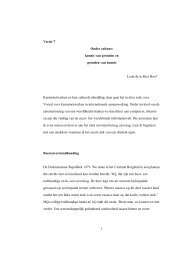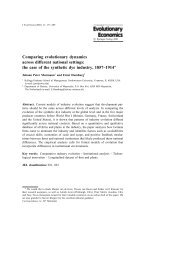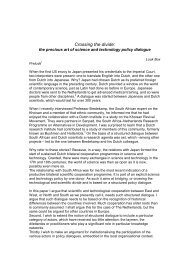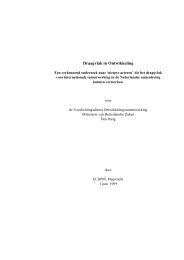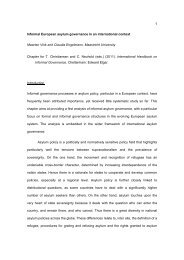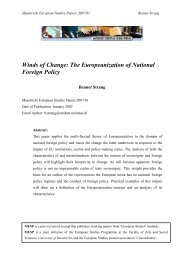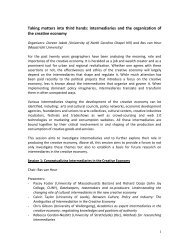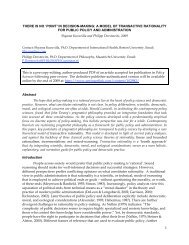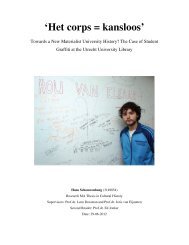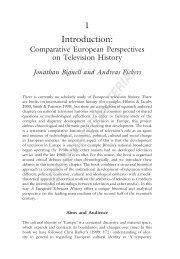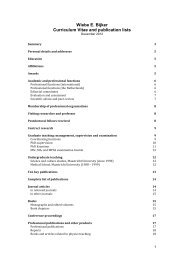Download paper - Maastricht University
Download paper - Maastricht University
Download paper - Maastricht University
Create successful ePaper yourself
Turn your PDF publications into a flip-book with our unique Google optimized e-Paper software.
<strong>Maastricht</strong> European Studies Papers 2007/07 L. Unbehauen<br />
The Bologna Process:<br />
Does à la carte hinder overall success of reform?<br />
<strong>Maastricht</strong> European Studies Papers 2007/07<br />
Date of Publication: October 2007<br />
Lena Unbehauen<br />
Email Author: l.unbehauen@student.unimaas.nl<br />
Abstract<br />
This <strong>paper</strong> investigates the crucial current state of the Bologna Process - an<br />
intergovernmental agreement among 45 pan-European states to harmonize the<br />
European higher education systems. After a short description of the nature and<br />
the development of the Bologna Process, the <strong>paper</strong> mainly analyses the<br />
Commission’s role as consensus-promoter. It also reveals that national<br />
sensitivities still challenge such a consensus culture and thus hinder reform.<br />
Therefore, this <strong>paper</strong> claims that the success of the Bologna Process mainly<br />
depends on the thorough implementation of the whole reform package. So far<br />
reform is hampered in the European Higher Education Area by incoherent à la<br />
carte implementation among the participating members. Six fields of national<br />
resistance to harmonization can be identified: the balance of incoming and<br />
outgoing students, introduction of the two-cycle structure, loss of educational<br />
diversity, language of instruction, commercialization of higher education and<br />
finally the establishment of a European system of quality assurance (QA) and<br />
accreditation. With reference to the Trend IV analysis of the European<br />
<strong>University</strong> Association a snapshot of the current state of the incomplete<br />
implementation in the Member States is given.<br />
MESP is a peer-reviewed journal that publishes working <strong>paper</strong>s from ‘European Studies’ students.<br />
MESP is a joint initiative of the European Studies Programme at the Faculty of Arts and Social Sciences,<br />
<strong>University</strong> of <strong>Maastricht</strong>, and the European Studies student association ‘Concordantia’.
<strong>Maastricht</strong> European Studies Papers 2007/07 L. Unbehauen<br />
Table of Contents<br />
1. Introduction 3<br />
2. Nature of the Bologna Process: a Non-Binding Intergovernmental Agreement 4<br />
3. The Content and Development of the Bologna Process 6<br />
4. The Strategies of the European Commission to Promote Consensus 9<br />
5. Challenges to Consensus Culture: Issues of National Sensitivity 11<br />
6. Current State of the Reform Process 15<br />
7. Conclusion: Factors on the Road to Success 17<br />
References 19<br />
List of abbreviations 22<br />
Appendix 23<br />
2
<strong>Maastricht</strong> European Studies Papers 2007/07 L. Unbehauen<br />
1. Introduction<br />
Higher education has all times been a very sensitive policy area of the nation state. It<br />
encompasses two notions, namely a cultural and an economic conception. In previous decades<br />
the cultural design, the decent education of the next generation of citizens and their<br />
socialization with certain values, used to be more important. However, external and internal<br />
pressures such as globalization, the ascend of the ‘knowledge economy’, the aging labor<br />
force, increased cross-border mobility and the technological revolution in terms of<br />
information and communication (Keeling, 2006, p. 215) have turned the image in favor of the<br />
economic rational - a rational which is also stressed by influential players like the European<br />
Commission. The most significant development these factors have triggered is the so-called<br />
Bologna Process, an intergovernmental agreement among 45 pan-European states to<br />
restructure and to harmonize the European higher education systems.<br />
Consequently, the question arises to what extent the Bologna Process constitutes a<br />
proof for a shift towards a consensus culture in higher education policy. As a matter of fact, a<br />
wide-spread consensus exists on the purpose of the reform as such but the degree to which<br />
change is supported by national actors is questionable. Therefore, this <strong>paper</strong> claims that the<br />
success of the Bologna Process mainly depends on the thorough implementation of the whole<br />
reform package. That means that a Bologna à la carte implementation, which is currently<br />
present, has to be avoided to ensure real achievements.<br />
In order to analyze all angles of this issue, the <strong>paper</strong> will be structured in the following<br />
way. First, the intergovernmental, non-EU-related nature of the process will be clarified,<br />
followed by a rough sketch of the objectives and priorities set out in the Bologna Declaration<br />
and in its follow-up work. Parallel the developing process and the extension of membership<br />
will be outlined. The third section investigates the steadily increasing role of the European<br />
Commission in the Bologna follow-up group (BFUG). Furthermore, the Commission’s<br />
ambition to promote consensus and innovation in the Bologna Process is examined by looking<br />
at its funding and discourse strategies. To give a balanced picture of this process, the fourth<br />
part focuses on the challenges to such consensus, concentrating on six fields where national<br />
resistance to harmonization is present: the balance of incoming and outgoing students,<br />
introduction of the two-cycle structure, loss of educational diversity, language of instruction,<br />
commercialization of higher education and finally the establishment of a European system of<br />
quality assurance (QA) and accreditation. Subsequently, with reference to the findings of the<br />
3
<strong>Maastricht</strong> European Studies Papers 2007/07 L. Unbehauen<br />
Trend IV analysis of the European <strong>University</strong> Association (EUA), a snapshot of the current<br />
state of progress will be provided that prepares the overall conclusion.<br />
2. Nature of the Bologna Process: a Non-Binding Intergovernmental<br />
Agreement<br />
Once asked what the Bologna Process really is, most students studying abroad can only come<br />
up with vague answers. This is alarming because these students are actually the living<br />
example of what this process is about: student mobility and the establishment of a European<br />
Higher Education Area (EHEA) by 2010 1 (Bologna Declaration, 1999). Due to this obvious<br />
knowledge gap the author deems it necessary to first clarify the very nature, content and<br />
development of this educational reform process.<br />
By definition, the Bologna Process is a synonym for a thorough reform of Europe’s<br />
higher education systems, which has been footed upon the intergovernmental agreement of<br />
currently 45 pan-European members to converge their degree structures and means of quality<br />
assessment into a common framework (Bologna Declaration, 1999). The overall aim is to<br />
promote the comparability of degrees which in itself is a prerequisite for the aspired increase<br />
in transnational mobility in the educational sector.<br />
It is not based on a binding treaty but builds upon the Bologna Declaration of 1999<br />
and several policy documents that have been adopted by the ministers responsible for higher<br />
education of the participating countries in the post-1999 follow-up process. Due to the fact<br />
that these documents are not legally binding, “it is the free will of every country and its higher<br />
education community to endorse or reject the principles of the Bologna Process, although the<br />
effect of ‘international peer pressure’ should not be underestimated” (Council of Europe,<br />
2006, p. 1) as individual countries might fear to fall behind the mainstream of change. Its<br />
voluntary and flexible approach, however, demonstrates the sensitivity of education policy<br />
which functions as a cornerstone of national sovereignty and national cultural heritage and is<br />
also the reason for delay of reforms and implementation problems. To calm national concerns<br />
it is repeatedly emphasized that the goal of establishing the EHEA is not foreseeing the<br />
embodiment of a “single education policy, but rather embracing a diversity of national<br />
education systems which learn to interact” (Norwegian Ministry of Education and Research,<br />
1 The Bologna Process should facilitate translation of one system to the other and therefore contribute to the<br />
increase of student and staff mobility and their employability. Moreover, it should boost the quality and<br />
attractiveness of European higher education for non-Europeans.<br />
4
<strong>Maastricht</strong> European Studies Papers 2007/07 L. Unbehauen<br />
2004a, p. 1). According to official declarations, the process aims at creating convergence but<br />
not harmonization or complete uniformity of the national education systems. Yet, these<br />
statements must be assessed critically because they have been part of the EU Commission’s<br />
rhetorical discourse strategy, attempting to play down actual power shifts and quickly<br />
extending developments in the European education fields.<br />
As already mentioned the Bologna Process is rooted in an intergovernmental<br />
agreement, however, “its extended membership places it clearly outside the EU’s formal<br />
policy-making processes” (Keeling, 2006, p. 207). Its size has increased from originally 29 to<br />
currently 45 participating countries 2 , proceeding with different reform speeds 3 (Council of<br />
Europe, 2006, p. 3). Its implementation is organized on international, national and<br />
institutional level. On an international level, the Bologna follow-up group has been installed<br />
since 2001, responsible for the continuing development of the process, planning of the next<br />
ministerial conference, organizing ‘Bologna seminars’ as well as considering new<br />
applications for membership. It consists of all signatory countries and the European<br />
Commission as well as the Council of Europe, EUA, ESIB, EURASHE, UNESCO-CEPES,<br />
ENQA, Educational Pan-European Structure and UNICE as consultative stockholders (p. 1).<br />
The Board and Secretariat, chaired by the current EU-presidency, control and assist the work<br />
of the BFUG. This link between international cooperation and national implementation,<br />
involving national ministries of education, rectors’ conferences, student unions and quality<br />
assurance agencies, can only be achieved by actively engaging all members; for it is the<br />
national players that decide over introducing ECTS, degree structures, mobility programs and<br />
national funding (Norwegian Ministry of Education and Research, 2004b, p. 1). The<br />
institutional level is also crucial for the actual implementation of the Bologna objectives and<br />
problems arise from varying priorities in each country and each institution, picking out what<br />
they like best and neglecting less favorable obligations. This level involves mainly higher<br />
education institutions, their faculties or departments and student and staff representatives<br />
(Council of Europe, 2006, p. 1).<br />
In other words, the whole “reform agenda is implemented in a decentralized way at<br />
the national level, but closely monitored and advanced by European-level reports,<br />
2 See appendices for a map of participating states<br />
3 Participants since 1999: Austria, Belgium, Bulgaria, Czech Republic, Denmark, Estonia, Finland, France,<br />
Germany, Greece, Hungary, Iceland, Ireland, Italy, Latvia, Lithuania, Luxembourg, Malta, the Netherlands,<br />
Norway, Poland, Portugal, Romania, Slovak Republic, Slovenia, Spain, Sweden, Switzerland, United Kingdom;<br />
- from 2001: Croatia, Cyprus, Liechtenstein, Turkey;<br />
- from 2003: Albania, Andorra, Bosnia and Herzegovina, the Holy See, Russia, Serbia and Montenegro, “the<br />
former Yugoslav Republic of Macedonia”;<br />
- from 2005: Armenia, Azerbaijan, Georgia, Moldavia and Ukraine.<br />
5
<strong>Maastricht</strong> European Studies Papers 2007/07 L. Unbehauen<br />
conferences, communiqués and policy declarations, which are all structured around a series of<br />
biennial ministerial meetings” (Keeling, 2006, p. 207).<br />
3. The Content and Development of the Bologna Process<br />
The first incentive for closer European cooperation in the field of education was given by the<br />
so-called Sorbonne Declaration, signed the 25 th of May 1998 by the education ministers of<br />
France, Italy, the United Kingdom and Germany. Its aim was the harmonization of the<br />
architecture of the European Higher Education System, focusing on progressive convergence<br />
of the overall framework of degrees and cycles, a common degree level system and the<br />
facilitation of student and teacher mobility (Norwegian Ministry of Education and Research,<br />
2004c, p.1). This precursory declaration was the necessary push for the Bologna Declaration,<br />
which was adopted on the 19 th of June 1999 by 29 ministers of higher education.<br />
The Bologna Process can be divided into ten interlinked action lines that together form<br />
a comprehensive reform package. The six original objectives which form the core of the<br />
Bologna Process are defined as followed:<br />
1. Adoption of a system of easily readable and comparable degrees<br />
This includes that from 2005 onwards a Diploma Supplement has to be given to all<br />
students automatically when they graduate without charging a fee. In this supplement,<br />
issued in one mayor European language, the content and type of study are explained in<br />
order to promote greater insight for future employers from other countries or further<br />
studies (Bologna Declaration, 1999).<br />
2. Adoption of a system essentially based on two main cycles<br />
This action line demands the introduction of a three years undergraduate cycle (Bachelor)<br />
whose successful completion is the prerequisite for the graduate cycle (Master). The<br />
Bachelor degree will also be sufficient as an appropriate level of qualification for the labor<br />
market (ibid.). The introduction of these two main cycles has taken varying speeds in the<br />
member states, mostly due to fears that the “new system would threaten the quality of<br />
degrees (…) and undermine their proud academic tradition” (Coss, 2004, p. 1).<br />
6
<strong>Maastricht</strong> European Studies Papers 2007/07 L. Unbehauen<br />
3. Establishment of a system of credits<br />
The aim of launching a European Credit Transfer and Accumulation System, short ECTS,<br />
is to promote greater student mobility. One ECTS is received for a specific workload of<br />
about 30 hours. However, it is the higher education institutes who determine how much<br />
learning effort a certain module requires and therefore, who decide on the number of<br />
ECTS obtained (Bologna Declaration, 1999).<br />
4. Promotion of mobility<br />
This issue entails that obstacles to student and staff mobility should be removed. Students<br />
should be able to take national student loans and grants across national borders because a<br />
lack of pecuniary support is often a legitimate reason for students to not study abroad. The<br />
mobility of teachers, researchers and administrative staff should be facilitated by<br />
recognizing and appreciating working periods abroad without prejudicing their statutory<br />
rights (ibid.).<br />
5. Promotion of European cooperation in quality assurance<br />
To assure this ambitious goal, the European Association for Quality Assurance in Higher<br />
Education has been set up in 2000 which disseminates information, experiences and good<br />
practices in the field of QA in higher education to European QA agencies, public<br />
authorities and higher education institutions (ENQA Secretariat, 2006). The overall aim is<br />
to establish an adequate system of peer review to guarantee comparable quality and<br />
accreditation. However, many countries do not want to give up their national sovereignty<br />
on the important issue of quality assessment.<br />
6. Promotion of the European dimension in higher education<br />
This vague-sounding objective refers to curriculum development, inter-institutional<br />
cooperation in form of joint diplomas, mobility schemes such as Erasmus-Socrates or<br />
Erasmus-Mundus as well as integrated programs of study, research and training.<br />
Moreover, according to this action line, the conditions for international students should be<br />
enhanced and information about the study possibilities on a European level should be<br />
provided to both national and foreign students (Bologna Declaration, 1999).<br />
7
<strong>Maastricht</strong> European Studies Papers 2007/07 L. Unbehauen<br />
Since the Bologna Declaration in 1999, there have been regular ministerial conferences<br />
every two years. The 2001 conference in Prague issued the so-called Prague Communiqué<br />
which added three additional elements of importance to the original core objectives.<br />
7. Lifelong learning<br />
The idea of lifelong learning has been emphasized in order to counter the challenges of<br />
competition and to promote the use of new technologies and the greater social cohesion.<br />
This also includes the recognition on vocational training and the focus on media skills<br />
(Prague Communiqué, 2001).<br />
8. Higher education institutions and students<br />
Here the need to involve universities and students as active and knowledgeable partners<br />
when conducting European-wide education policy is acknowledged. Furthermore, it is<br />
stated that students should participate and shape the organizational structures and content<br />
of higher education institutes because they are the first to be concerned by these issues<br />
(ibid). Thus, in the Prague Communiqué the active involvement of the European<br />
<strong>University</strong> Association (EUA, before named CRE) and the National Unions of Students in<br />
Europe (ESIB) as consultative members of the BFUG has been established.<br />
9. Promoting attractiveness of the EHEA (transnational education)<br />
According to the members of the Bologna Process it is important to make the profile of<br />
the EHEA more attractive for students from Europe and worldwide (ibid). In order to<br />
improve the comparability of European higher education degrees in other parts of the<br />
world, a common framework of qualifications and a coherent quality assurance and<br />
accreditation mechanism have to be developed to stay competitive in regard to other<br />
educational players such as the USA. The rationale is that as soon as ‘knowledge made in<br />
Europe’ becomes a recognizable label of qualification, it will be also draw students and<br />
high-skilled workers from all over the world.<br />
At the ministerial summit in Berlin in September 2003, a 10 th action line, namely the<br />
emphasis on doctorial studies (as the third educational cycle) and the synergy between the<br />
EHEA and the European Research Area (ERA) has been promoted. Moreover, three<br />
immediate priorities were singled out that were the most pressing and needed the greatest<br />
attention in the up-coming two years. These were: quality assurance (QA), the two-cycle<br />
8
<strong>Maastricht</strong> European Studies Papers 2007/07 L. Unbehauen<br />
degree system and the recognition and periods of studying. Especially the issue of developing<br />
common criteria and methodologies for national QA was a hot topic. The educational<br />
ministers demanded that by 2005 national QA agencies should clearly define the<br />
responsibility of involved institutions, evaluate programs and institutions through internal<br />
assessment, external review, participation of students and the publication of results as well as<br />
a system of accreditation, certification or comparable procedures, international participation,<br />
co-operation and networking (Berlin Communiqué, 2003). The commitment to adopt<br />
guidelines and standards for QA has also been the focus of the last conference in Bergen in<br />
2005.<br />
This ambition will be, however, difficult to realize because of the variety of QA<br />
systems that exist on the national level. Even countries with very similar structures (most-<br />
likely case) such as the Belgian Flanders and the Netherlands had to overcome various<br />
differences regarding procedures and strategies until they could establish the Dutch-Flemish<br />
Accreditation Organization NVAO in 2004 (Dittrich, Frederiks & Luwel, 2004, p. 300). The<br />
differences stem from “different cultures and traditions, but also different policy objectives<br />
and differences in policy implementation” (p. 309). The first set of disparity can be traced<br />
back to the procedural workings in a country, such as different authorization procedures for<br />
temporary accreditation and duration of accreditation (8 years in Flanders, 6 in the<br />
Netherlands). For example, in Flanders the decision to grant accreditation has to be taken in<br />
four months (three in the Netherlands); submission of application for accreditation is<br />
prescribed more in detail and application costs are lower than in the Netherlands; and<br />
complaints and appeal procedures differ as well (p. 311). This example demonstrates the<br />
complexity of establishing a European-wide system of QA which remains an open issue to<br />
debate on the agenda of the Bologna Process.<br />
4. The Strategies of the European Commission to Promote Consensus<br />
When looking at the Bologna Process so far, it seems like a natural development that at least<br />
the members of the EU would give up their sovereignty in this field and pool their education<br />
policies. However, this trend has proven to be a contested and lengthy process. This is<br />
confirmed by the fact that despite acknowledging the extension of the EU’s higher education<br />
activities, the EU’s sphere of influence has been limited in the Treaty of <strong>Maastricht</strong> to<br />
encourage international mobility and to “only support and complement policy action at the<br />
9
<strong>Maastricht</strong> European Studies Papers 2007/07 L. Unbehauen<br />
national level, while further respecting their responsibility for the content of education, the<br />
structure of educational systems, and their cultural and linguistic diversity” (Huisman & Van<br />
der Wende, 2004, p. 349). 4<br />
Despite its restricted authority, the EU Commission has been a driving force behind<br />
the process and has used several strategies to increase its powers in the field of education by<br />
constructing sort of a consensus culture among the members of the Bologna Process. In such<br />
way the Commission also attempted to legitimize its key role concerning the education policy<br />
of the EU (Huisman & Van der Wende, 2004). That means that the Bologna Process is<br />
intensively shaped by the involvement of the Commission, which constitutes the only full<br />
non-state member - although the original plan was to place the Bologna Process completely<br />
outside the framework of the EU.<br />
Due to the fact that the Commission was only legitimized to act in the field of the four<br />
freedoms (mobility of goods, persons, services and capital), its strategy was to concentrate on<br />
the promotion of greater student mobility. Consequently, it created the ERASMUS program<br />
in 1987 which encouraged students to study abroad. The success of the program 5 in<br />
combination with the EU funds has “probably removed some of the suspicions of national<br />
governments regarding EU intrusion in domestic affairs“(p. 351). Thus, the EU’s focus on<br />
student and staff mobility has provided an apparently neutral and easy-to-digest approach,<br />
concerning an area which is less threatening national sovereignty than other educational<br />
issues. Moreover, the increased exchange of students made the still existing obstacles more<br />
visible. Neave (2003, p. 151) suggests that “mass mobility laid bare a very shocking diversity<br />
(…) which now posed real and practical problems to the builders of a European ‘higher<br />
education area’”, relating to quality, transfer of credits, language of instruction and structural<br />
features of the national education sectors (Huisman & Van der Wende, 2004, p. 350).<br />
Through financial incentives for mobility schemes the Commission has build trust and has<br />
also fostered its role as influential member in the BFUG. In fact, according to Ruth Keeling<br />
“many of the Bologna initiatives are ‘mainstreaming’ solutions first developed by the<br />
Commission” (Keeling, 2006, p. 208). For instance, ECTS, first developed within the<br />
Erasmus framework, was later accepted as a European-wide standard in the Bologna<br />
Declaration (ibid.).<br />
4 <strong>Maastricht</strong> Treaty, 1992 (Chapter 3, article 126): “The Community shall contribute to the development of<br />
quality education by encouraging cooperation between Member States”, particularly with regard to the European<br />
dimension and international mobility.<br />
5 By 2005 1.4 million European students have spend a period of their studies in another European country<br />
(European Commission, 2005)<br />
10
<strong>Maastricht</strong> European Studies Papers 2007/07 L. Unbehauen<br />
At the same time, the Commission has used a specific discourse strategy to increase<br />
consensus in higher education, constructing it as “purposeful, progressive, successful,<br />
economically beneficial, collaborative and international” (p. 211). Not only globalization<br />
itself but also the rhetoric emphasis placed on European competitiveness by the Commission<br />
has led to a new concept of higher education. Unlike in previous decades, the national and<br />
cultural role of higher education is waning, while the economic rational gains importance<br />
(Huisman & Van der Wende, 2004, p. 350). The commercialization of education has become<br />
apparent in the Commission’s construction of higher education institutes as organizations that<br />
compete for students on an open market and whose performance is assessed by its measurable<br />
output, such as research, publications and applications for patents and number of European<br />
Nobel prize winners (Keeling, 2006, p. 209). The reforms pursued in the Bologna Process<br />
have also been linked to the research policy of the Lisbon Strategy, aiming at greater<br />
employability of the European citizens due to better skills and knowledge provided through<br />
education. The transnational and external dimension praised to the skies by the Commission is<br />
also an integral aspect of the wider Bologna Process (see action line 9). It presents higher<br />
education as an important arena for competition vis-à-vis the US and China, concerning for<br />
example the attraction of foreign students and the ranking of its universities. It can be said that<br />
the Commission’s perspective of higher education has become widely-accepted among the<br />
members of the Bologna Process and has increasingly shaped its development. It has managed<br />
to become an important agenda-setter in the Bologna Process, “playing a central role in<br />
maintaining the momentum of current political debate [in the area of education], and steering<br />
their convergence in ways which have affirmed its own centrality” (Keeling, 2006, p. 215).<br />
Scholars like Ruth Keeling have termed this expansion of the Commission’s influence on<br />
European education policy the so-called ‘snowballing’ effect (p. 212).<br />
5. Challenges to consensus culture: issues of national sensitivity<br />
However, education will always remain an area of dispute and challenge and one should not<br />
blindly acknowledge the Bologna Process as a completely smooth development towards<br />
greater acceptance of supra- or international interference in domestic education policy. On the<br />
contrary, it should not be forgotten that the Bologna Process is only a general policy program,<br />
while its outcomes are still largely determined by the power of national governments and<br />
other stakeholders as well as their will to implement the restructuring measures (Huisman &<br />
11
<strong>Maastricht</strong> European Studies Papers 2007/07 L. Unbehauen<br />
Van der Wende, 2004, p. 353). The apparent policy consensus, encouraged by the<br />
Commission, is challenged by national actors who raise objections in more sensitive areas.<br />
Six of these caveats are especially pressing. The first is the possible imbalance between<br />
incoming and outgoing international students (p. 353). How many international scholars are<br />
entering a system, will definitely depend on the attractiveness and status of the respective<br />
national higher education structure. Consequently, domestic policy-makers in countries with<br />
weaker and less reputable education systems fear that this could lead to a so-called brain-drain<br />
of their highly skilled student force. However, it should be acknowledged that this can also<br />
give the necessary push for such systems to modernize. Furthermore, one should keep in mind<br />
that most students, even if studying abroad, will in most cases return back home after<br />
receiving their degree because of cultural and family ties.<br />
The second area of national resentment is the restructuring of the national educational<br />
systems and the incompatibility of the new two-cycle arrangement with the traditional degree<br />
structure. Despite the easy transition in some countries, others have been more reluctant to<br />
introduce the Bachelor and Master structure. While the frontrunner Netherlands have<br />
introduced the ECTS and two-cycle system already in 2002/03 and have adjusted 82% of its<br />
academic programs (Leegwater, 2005, p. 5), Germany can only offer 26, 3 % of its degree<br />
programs according to the new system. The new structures exist parallel to the ‘traditional’<br />
German degrees, such as Magister and Diplom (Galler & Hendriks, 2005, p. 1). The belated<br />
switch to the two-cycle system, which is planned by 2009/10, is due to the decentralized<br />
structure of the German higher education sector and the Kulturhoheit (cultural autonomy) of<br />
Germany’s Länder who can act as veto players in the restructuring process. In the UK the<br />
two-cycle structure is not easily compatible with its traditional two-year foundation degrees<br />
and in Portugal there is disagreement on the duration of the first cycle. Greece is lagging<br />
behind, also due to the resistance to restructuring by its academic elite and student bodies.<br />
Here academics are frightened that pressures such as internationalization and globalization<br />
could ultimately result in the degradation of the public university (Reichert & Tauch, 2003).<br />
Another national concern, voiced by the Portuguese scholars Amaral and Magalhães is<br />
the possible loss of the most unique feature of the European Higher Education system: its<br />
diversity. The argument is that harmonization and the introduction of a more uniform and<br />
centrally planned European core curriculum, as recommended in the 2001 ‘Tuning<br />
Educational Structures in Europe’ project 6 , will increase bureaucracy and will stifle program<br />
6 The tuning project was launched on May 4 th 2001with financial support of the Commission to exchange<br />
information and to pinpoint some common subject-based reference points, curriculum content, learning<br />
outcomes and teaching methods in order to advance the quality of European higher education. In the area of<br />
12
<strong>Maastricht</strong> European Studies Papers 2007/07 L. Unbehauen<br />
diversity and institutional autonomy (Amaral & Magalhães, 2004, p. 87/88). This coincides<br />
with the general fear that Brussels’ bureaucrats could acquire too much power and form a new<br />
oligarchy. Scholars like Sursock emphasize that diversity and institutional autonomy are the<br />
cradle of innovation and creativity and that some “constructive ambiguity” is needed to<br />
maintain “vibrancy vitality and variety” (Sursock, 2002) in Europe’s Higher Education<br />
system<br />
The fourth challenge to consensus is the cultural and therefore heatedly debated issue<br />
of the language of instruction. The aim of the language policy in most countries is certainly<br />
the preservation of the national language. In Germany teaching in English is still a very hot<br />
potato which has to be handled with care to calm critics that predict the loss of Germany’s<br />
cultural heritage; a concept that is principally defined by the German language as common<br />
connector. A similar situation exists in Greece, where the encouragement of the Greek<br />
language and culture is an integral element of its internationalization policy by subsidizing<br />
Greek language courses in and outside of the country’s borders (Huisman & Van der Wende,<br />
2004, p. 355). The Dutch language policy has taken its advantage out of this disagreement and<br />
has added attractiveness to its system by changing to English as language of instruction.<br />
Without much discussion, more than half of its bachelor and Master programs are now taught<br />
in English 7 .<br />
The fifth area of concern is the commercialization of higher education. The<br />
competitive image of education, coined by the Commission, pushes for result-driven<br />
education and research that can face the cost-benefit test in today’s globalized world. This<br />
picture leaves little space for alternative concepts on what education should achieve and<br />
reduces other goals such as non-productive research, familiarizing students “to the life of the<br />
mind” (Newman, 2000, p. 6), personal self-awareness and satisfaction of curiosity, in rank<br />
(Keeling, 2006, p 214). It seems like the original purpose of learning, namely to understand<br />
the world around oneself, is being replaced by output-based education machinery which<br />
neglects to value arts that do not bring money. Furthermore, by emphasizing so much on<br />
research, teaching as such will take a back seat and the counseling and guiding role of<br />
professors and tutors might vanish. Scholars like Henkel (2001) even go that far to predict a<br />
“loss of a sense of vocation”.<br />
chemistry or mathematics, for instance, it prescribed compulsory modules, minimum credits as well as certain<br />
subject knowledge outcomes.<br />
7 385 of 647 Master programmes in the academic year 2004/05 were provided in English (Leegwater, 2005, p.<br />
13). This policy might be due to the fact that the small Netherlands try to gain an advantage vis-à-vis their<br />
education competitors and due to the wide-spread acceptance and knowledge of English among the Dutch<br />
population.<br />
13
<strong>Maastricht</strong> European Studies Papers 2007/07 L. Unbehauen<br />
The probably hottest topic of debate is the move towards a European accreditation<br />
system. Since the beginning, quality assurance (QA) has been pursued by the education<br />
ministers with less emphasis than the other action line of the Bologna Process. In the original<br />
Bologna Declaration the wording “promotion of European co-operation in quality assurance<br />
with a view to developing comparable criteria and methodologies” (Bologna Declaration,<br />
1999) is rather vague and shows a lack of commitment by the member states. However, this<br />
vacuum has been filled in the Bologna follow-up process and has been advanced to one of the<br />
main points of attention, despite its weak base in the founding declaration (Haug, 2003, p.<br />
230). This is due to the fact that the consistent, compatible, internally and externally readable<br />
common framework of European degrees is undermined if no mutual mechanism for QA is in<br />
place (p. 230). Simply put, the first requires the second because homogeneous quality buys<br />
mutual trust. Nevertheless, there are always also those members who fear externally inflicted<br />
standards, as inadequate for their national system and a hindrance to innovation for its higher<br />
education institutions (Lourtie, 2001, p. 16).<br />
According to Haug, in order to anticipate these apprehensions, the following<br />
developments should be prevented. First, QA should not become a monopoly imposed from<br />
one single European accreditation agency. Instead there is a need for multiple accreditation<br />
and private accreditation initiatives. Second, it ought not to be a ranking system. Multilateral<br />
accreditation is footed on threshold criteria and indicates a minimum floor of standards,<br />
instead of officially ranking universities. Such league tables are rather established by the<br />
media. Third, the form of a superstructure as well as any additional level of bureaucracy for<br />
universities has to be avoided. In other words, QA self-assessment, external audits and reports<br />
drawn up on an institutional or national level do not have to be repeated at the European<br />
stage. And last but not least, the system of European QA should not be shielded from other<br />
international forms of QA World-wide in order to assure the attractiveness of European higher<br />
education abroad (Haug, 2003, p. 236/237). To solve this heated discussion on European QA,<br />
Haug presents the concept of “meta-accreditation, a multilateral system based on some form<br />
of accreditation of accreditation agencies (…) [meaning that] if quality<br />
assurance/accreditation in a given region or sector is indeed well done and trustworthy, then<br />
the work should not be redone at European level” (p. 232). This decentralized approach fits<br />
into the general concept of subsidiarity and allows a diversity of QA agencies that are<br />
connected by a common set of quality criteria (such as composition of the agency, its<br />
standards and procedures, critical size, independence) (p. 233/234). Whether this proposal<br />
14
<strong>Maastricht</strong> European Studies Papers 2007/07 L. Unbehauen<br />
will dissolve the fears of all participating states and constitute consensus in this contested area<br />
is questionable. Yet, it can be used as a reasonable basis for more dialogue and development.<br />
6. Current State of the Reform Process<br />
As it could be already expected, no homogeneous picture of the Bologna Process exists<br />
among all member countries. This is due to different starting conditions and educational<br />
systems (some countries had already traditionally a two-tier structure or a credit system) as<br />
well as diverse times of entry into the whole reform process. However, one of the most<br />
important reasons is the non-binding nature of the Bologna Process and the national<br />
preference to implement only selective elements of the reform which coincide with national<br />
priorities. Therefore, the National Union of Students in Europe (ESIB) has stressed in its 2005<br />
report “Bologna with student eyes” that “Bologna still must not be understood as pick and<br />
choose supermarket” (ESIB, 2005, p. 3).<br />
A half time snapshot of the reform towards an EHEA by 2010 is provided in great<br />
detail by EUA’s Trend IV report 8 and ESIB’s 2005 Bologna Analysis, which will serve as a<br />
basis for the upcoming section. Yet, due to the scope of this <strong>paper</strong> only a few relevant issues<br />
of insufficient implementation will be highlighted here.<br />
First, the introduction of three cycles (bachelor, master, doctorial cycle) had triggered<br />
profound structural change in most participating countries 9 . Nevertheless, little attention has<br />
been devoted to the aligned need to also redevelop the curricula when drawing up new<br />
courses. According to the Trend IV findings, the three-year bachelor cycle has been<br />
“mistakenly regarded as a compressed version of former long-cycle programmes” (Reichert &<br />
Tauch, 2005, p. 6) although bachelors are not constructed in the first place to equip the<br />
students with the same degree of knowledge and skills as traditional five-year courses (p. 14).<br />
However, the fact that universities have often only relabeled old programs and have tried to<br />
cram in the content of previous long-cycle courses, without using their chance to ‘clear out’<br />
the curriculum, has let to extremely compact programs (ibid). Moreover, a general trend or<br />
pedagogical shift can be noticed away from traditional teacher-centered towards more<br />
8 The Trend IV report provides an analysis of how institutional actors, such as universities, respond to the<br />
challenges of implementing the Bologna Process. Its results are based on sixty-two site visits in twenty-nine<br />
European countries and questionnaires from national rectors’ conferences. During the site visits rectors, deans,<br />
academics, junior staff, PhD candidates, students and administrators have been interviewed (Reichert & Tauch,<br />
2005, p. 10).<br />
9 However, regulated professions, such as medicine, where regulated bodies have a say are still excluded from<br />
the new two-tier system (Reichert & Tauch, 2005, p. 13)<br />
15
<strong>Maastricht</strong> European Studies Papers 2007/07 L. Unbehauen<br />
student-centered learning (p. 47). Also my own university, the <strong>University</strong> of <strong>Maastricht</strong>, has<br />
picked up this new approach by focusing on so-called Problem-Based Learning, which<br />
involves a great amount of self-study and extensive group discussions on the learned content.<br />
Furthermore, many governments have failed to inform both students and employers on the<br />
value and meaning of the bachelor and to restructure their own public service employment<br />
practices (p. 15). Both issues are a reason for the only reluctantly growing acceptance of the<br />
new degree structures in society.<br />
Second, concerning recognition the Diploma Supplement has been implemented by all<br />
member countries by 2005. However, due to technical problems (software programs, data<br />
flow between universities and central administration etc.) and troubles with translation, some<br />
institutions do not issue to all graduates (case in Greece, Denmark and Germany),<br />
automatically (in Central and Eastern Europe), free of charge (in Hungary, Serbia and<br />
indirectly in Turkey) and a widely spoken European language (in Hungary and Romania only<br />
issued in national language) (ESIB, 2005, p. 34/35). Both the Trend IV and the ESIB report<br />
regard, its main weakness remains the lack of inclusion of learning outcomes, as well as<br />
program details which would […] to supply the necessary information on the knowledge and<br />
proficiency of the degree-holder (Reichert & Tauch, 2005, p. 27; ESIB, 2005, p. 35/36). The<br />
majority of Higher Education Institutes (HEIs) use ECTS as a unit for both accumulation and<br />
transfer (in Austria, Belgium, Czech Republic, Estonia, France, Germany, Hungary, Ireland,<br />
Italy, Latvia, Lithuania, the Netherlands, Romania, Sweden and Switzerland) or are at least<br />
working on its implementation (Bulgaria, Croatia, Finland, Poland, Spain and Portugal), while<br />
the UK and Turkey still limit the use of ECTS to student mobility only (Reichert & Tauch,<br />
2005, p. 23). The fact that HEIs decide independently on how much ECTS should be granted<br />
for a certain module leads to diverging and sometimes even contradicting practices. ESIB<br />
criticizes that professors roughly estimate the workload (which provides the basis for the<br />
amount of credits obtained), instead of referring to student input when calculating the ECTS<br />
amount 10 . Thus it can be said that the student workload is inappropriately measured because it<br />
is mostly based on contact hours with professors, neglecting the students’ time spent on self-<br />
study (ESIB, 2005, p. 47). Simply put, it can still not be relied upon that one ECTS in one<br />
country equals one ECTS in another country.<br />
Thirdly, Trend IV findings prove that a correlation exists between improved QA<br />
within institutions and the level of institutional autonomy (Reichert & Tauch, 2005, p. 7). It<br />
has been shown that HEIs in countries that grant most institutional autonomy (namely UK,<br />
10 Good practices in obtaining student input for the calculation of ECTS exist in Estonia, Finland, the<br />
Netherlands, Norway and the UK (ESIB, 2005, p. 44).<br />
16
<strong>Maastricht</strong> European Studies Papers 2007/07 L. Unbehauen<br />
Ireland, Finland, the Netherlands, Denmark and Austria) take the European lead, in regard to<br />
internal quality assessment. Other HEIs that are under more severe restrictions as for instance<br />
in Belgium, Greece and some Länder of Germany display a less coherent internal QA (p. 32)<br />
because they are not independent in the selection of students and staff.<br />
The above-mentioned problems give only a short review of the current state of the<br />
Bologna Process. Nonetheless, what becomes clear is that now that it is half way through,<br />
many practices exist on <strong>paper</strong> but in reality they are only partially implemented. After digging<br />
deeper underneath the smooth surface, it appears that, despite a continuous development of<br />
the Bologna Process into the right direction, not all that glitters is gold.<br />
7. Conclusion: Factors on the Road to Success<br />
It is undeniable that there has been ongoing development in higher education in the last<br />
decade. Education has turned into a common concern instead of being an isolated national<br />
policy field. The scholars Huisman and Van der Wende go even so far to say that “much of<br />
the fear of national governments for intervention in domestic affairs has been erased by<br />
positive experiences and developments” (2004, p. 355) such as the incorporation of<br />
internationalization into mainstream higher education policy, the rising student and staff<br />
mobility, the financial support through Commission funds and the political flexibility for<br />
governments in regard to implementation of Bologna objectives.<br />
However, it is also this flexibility which provides the participating states with a<br />
loophole. That means that, despite the consensus about a common need for reform, national<br />
states commit themselves to the Bologna Process in mainly rhetoric terms but when it comes<br />
to coherent implementation they are rather reluctant. This fact diverts from the concept of a<br />
cozy consensus which the Commission tries to foster in the field of European higher<br />
education. As the fourth part of this <strong>paper</strong> has illustrated, national players even voice dissent<br />
and challenge sensitive elements of the fast-evolving process that are not in line with national<br />
preferences. Neave explains the ‘power game’ like this:<br />
“The Bologna process has now reached the stage when principles begin to assume<br />
institutional form. And institutional form is not far removed from attributing mandates.<br />
Yet, he who speaks of mandates is but one step away from bringing up the fundamental<br />
question of control and co-ordination” (Neave, 2002, p. 10)<br />
17
<strong>Maastricht</strong> European Studies Papers 2007/07 L. Unbehauen<br />
Neave is right to argue that the reform process has reached a crucial stage. In the last years<br />
even the sensitive question of QA has come to the fore and the call for a common European<br />
QA mechanism has caused heated discussions. However, the success of this next reform<br />
phase and of the Bologna reform as such will depend mainly on the implementation of the<br />
whole reform package; implementation not only meaning a change to appropriate national<br />
legislation but also to actual practices at Europe’s HEIs. Unfortunately the findings of the<br />
Trend IV analysis have revealed that much remains to be done, even in such basic action<br />
fields as convergence of degree structure and recognition.<br />
Yet, the Trend IV report has also identified certain factors which can help the reform<br />
on its road to success. The first success factor is the positive perception of the aims and added<br />
value of the Bologna Process among HEIs across Europe. In other words, if the “top down<br />
agenda [is transformed] into their own bottom-up interpretation of desirable change”<br />
(Reichert & Tauch, 2005, p. 42), the reform will run more smoothly. Second, good<br />
communication within the institutions and a pro-active leadership can foster better<br />
cooperation and flawless implementation of the reform (ibid.). Thirdly, the right “balance<br />
between national level regulation and coordination and institutional autonomy” (p. 44) is<br />
needed to guide but not over-regulate the HEIs in their reform progress. National qualification<br />
frameworks should give incentives for action without prescribing too many rules on, for<br />
example, the language of instruction or accreditation of programs. The fourth reason for<br />
success is to allow the institution enough time to adjust instead of rushing them through half-<br />
cooked reforms (p. 46). It has proven that countries such as the Netherlands which started the<br />
implementation early could report the most thorough reform results (p. 45). Last but not least,<br />
not only rhetoric commitment but increased national funding is necessary. Until now most of<br />
the Bologna reforms and the associated higher administrative and staff costs had to be paid<br />
out of the limited pot of Europe’s HEI, leaving less resources for other fields such as research<br />
or intensive student counseling.<br />
If all these factors will be considered and incorporated into the reform strategy it might<br />
be possible to speed up the Bologna Process and make it a real success, which until now has<br />
been hindered by the selective and incoherent implementation of reforms among the<br />
participating members.<br />
18
<strong>Maastricht</strong> European Studies Papers 2007/07 L. Unbehauen<br />
References<br />
Amaral, A. & Magalhães, A. (2004). Epidemiology and the Bologna Saga. Higher Education,<br />
Vol. 48, 79-100<br />
Berlin Communiqué (2003). Realizing the European Higher Education Area. Communiqué of<br />
the Conference of Ministers responsible for higher education in Berlin on 19th of September<br />
2003. Retrieved June 7, 2006, from the World Wide Web:<br />
http://www.bologna-berlin2003.de/pdf/Communique1.pdf<br />
Bologna Declaration (1999). Towards the European Higher Education Area. Joint<br />
Declaration of the European Ministers of Education Convened in Bologna at the 19 th of June<br />
1999. Retrieved June 7, 2006, from the World Wide Web:<br />
http://europa.eu.int/comm/education/bologna_en.html<br />
Coss, S. (2004). New States set to pass education test. EU Studies Guide February 2004.<br />
European Voice. Retrieved June 7, 2006, from the World Wide Web:<br />
http://www.europeanvoice.com/eu/info<br />
Council of Europe. (2006). Bologna for Pedestrians. Retrieved June 7, 2006, from the World<br />
Wide Web:<br />
http://www.coe.int/t/dg4/highereducation/ehea2010/bolognapedestrians<br />
Dittrich, K., Frederiks, M. & Luwel, M. (2004). The Implementation of ‘Bologna’ in Flanders<br />
and the Netherlands. European Journal of Education, Vol. 39, No. 3, 299-316<br />
European Commission. (2005). Erasmus Networks now cover nine-tenths of Europe’s<br />
universities (October 20). Press Release (IP/05/1313). Brussels: European Commission<br />
European Network of Quality Assurance. (2006). Publications. Retrieved June 7, 2006, from<br />
the World Wide Web:<br />
www.enqa.eu/pubs.lasso<br />
ESIB-Bologna Process Committee. (2005). Bologna with student eyes. Retrieved June26,<br />
2006, from the World Wide Web:<br />
www.esib.org/documents/ESIBbolognaanalysis.pdf<br />
Galler, B. & Hendriks, B. (2005). National Reports 2004-05: Germany. Retrieved June 15,<br />
2006, from the World Wide Web:<br />
www.bologna-bergen2005.no<br />
Henkel, M. (2001). Policy Change and Academic Identities. Seminar Paper, Debates in<br />
Higher Education (November 6). London: <strong>University</strong> College<br />
Haug, G. (2003). Quality Assurance/Accreditation in the Emerging European Higher<br />
Education Area: a possible scenario for the future. European Journal of Education, Vol. 38,<br />
No. 3, 229-241<br />
Huisman, J. & Van der Wende, M. (2004). The EU and Bologna: are supra- and international<br />
initiatives threatening domestic agendas? European Journal of Education, Vol. 39, No. 3, 349-<br />
357<br />
19
<strong>Maastricht</strong> European Studies Papers 2007/07 L. Unbehauen<br />
Keeling, R. (2006). The Bologna Process and the Lisbon Research Agenda: the European<br />
Commission’s expanding role in higher education discourse. European Journal of Education,<br />
Vol. 41, No. 2, 203-222<br />
Leegwater, M. (2005). National Reports 2004-05: The Netherlands. Retrieved June 15, 2006,<br />
from the World Wide Web:<br />
www.bologna-bergen2005.no<br />
Lourtie, P. (2001). Report to the Ministers of Education of the signatory countries. Prague<br />
Neave, G. (2002). ‘Anything Goes: or, How the Accommodation of Europe’s Universities to<br />
European Integration Integrates – an Inspiring Number of Contradictions’, Bulletin of the<br />
<strong>University</strong> of Porto 10.35, 9-18<br />
Neave, G. (2003). The Bologna Declaration: Some of the historic dilemmas posed by the<br />
reconstruction of the Community in Europe’s systems of higher education. Educational<br />
Policy, Vol. 17, 141-164<br />
Newman, F. (2000). Saving Higher Education’s Soul. The Futures Project: Policy for Higher<br />
Education in a Changing World. Rhode Island: Brown <strong>University</strong><br />
Norwegian Ministry of Education and Research. (2004a). The Bologna Process from a<br />
Norwegian Perspective. Bologna-Bergen summit 2005. Retrieved June 7, 2006, from the<br />
World Wide Web:<br />
www.bologna-bergen2005.no<br />
Norwegian Ministry of Education and Research. (2004b). Handling the Bologna Process.<br />
Bologna-Bergen summit 2005. Retrieved June 7, 2006, from the World Wide Web:<br />
www.bologna-bergen2005.no<br />
Norwegian Ministry of Education and Research. (2004c). Basic Information. Bologna-Bergen<br />
summit 2005. Retrieved June 7, 2006, from the World Wide Web:<br />
www.bologna-bergen2005.no<br />
Prague Communiqué (2001). Towards the European Higher Education Area. Communiqué of<br />
the meeting of European Ministers in charge of Higher education in Prague on May 19 th<br />
2001. Retrieved June 7, 2006, from the World Wide Web:<br />
http://www.bologna-berlin2003.de/pdf/Prague_communiquTheta.pdf<br />
Reichert, S. & Tauch, Ch. (2003). Trends in Learning Structures in European Higher<br />
Education III. Bologna Four Years After: steps toward sustainable reform of higher<br />
education in Europe. Retrieved June 26, 2006, from the World Wide Web:<br />
www.eua.be<br />
Reichert, S. & Tauch, Ch. (2005). Trends IV: European universities implementing Bologna.<br />
Retrieved June 26, 2006, from the World Wide Web:<br />
www.eua.be<br />
20
<strong>Maastricht</strong> European Studies Papers 2007/07 L. Unbehauen<br />
Sursock, A. (2002). ‘Reflection from the higher education institutions’ point of view:<br />
Accreditation and quality culture’. Proceedings of the international conference on<br />
accreditation and quality assurance: Working on the European Dimension of Quality.<br />
Amsterdam, 42-48.<br />
21
<strong>Maastricht</strong> European Studies Papers 2007/07 L. Unbehauen<br />
List of abbreviations<br />
BFUG: Bologna follow-up group<br />
ECTS: European Credit Transfer and Accumulation System<br />
EHEA: European Higher Education Area<br />
ENQA: European Network for Quality Assurance in Higher Education<br />
ERA: European Research Area<br />
ESIB: National Unions of Students in Europe<br />
EUA: European <strong>University</strong> Association<br />
EURASHE: European Association of Institutions in Higher Education<br />
HEI: Higher Education Institute<br />
NVAO: Dutch and Flemish Accreditation Organization<br />
QA: Quality assurance<br />
UNESCO-CEPES: European Centre for Higher Education<br />
UNICE: Union of Industries in the European Union<br />
22
<strong>Maastricht</strong> European Studies Papers 2007/07 L. Unbehauen<br />
Appendix<br />
Members of the Bologna Process in 2005<br />
source: http://www.bologna-bergen2005.no<br />
23



